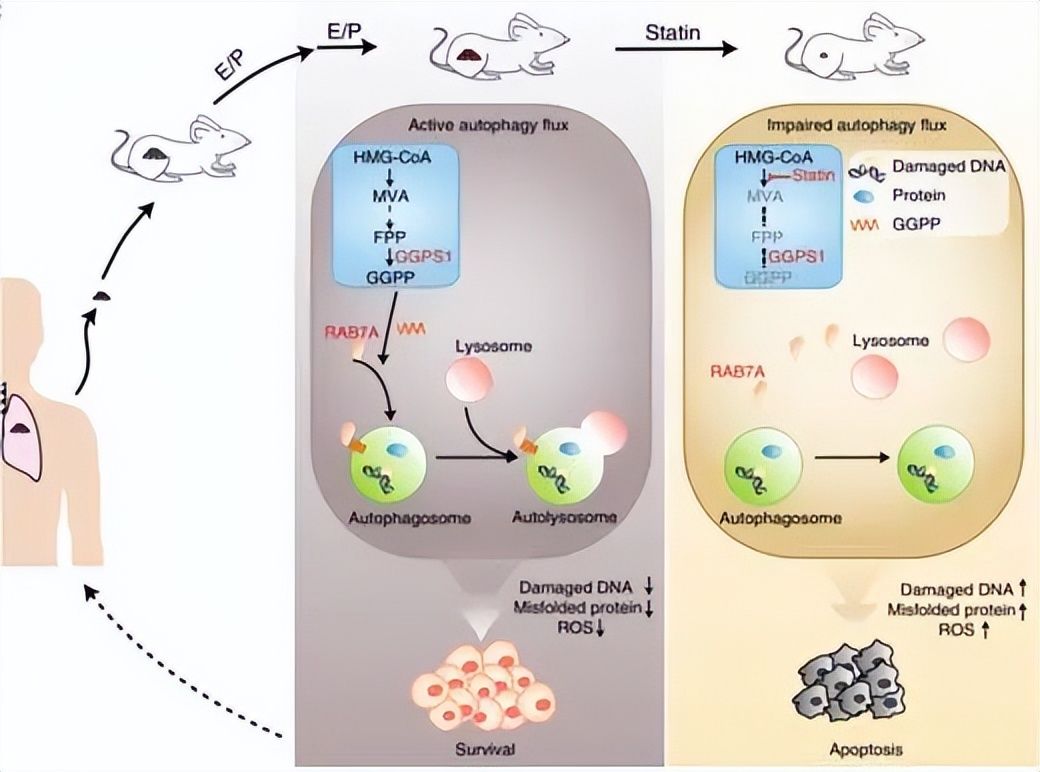Author: Guan Yanqing
Lung cancer is the number one killer of high-incidence cancers in my country. According to the latest cancer report in China released by the National Cancer Center this year, in 2016 alone, there were 828,000 new lung cancer cases and 657,000 deaths. Small cell lung cancer (SCLC) has the highest malignancy and lethality among all types of lung cancer, accounting for about 15% of lung cancer patients, with a 5-year survival rate of only 5%. High metastasis and susceptibility to drug resistance are the two most significant features of SCLC. [1-2]
Since SCLC is sensitive to chemotherapy, current first-line therapy is Combined etoposide and cisplatin (E/P), but patients are prone to drug resistance. Due to the lack of effective strategies to overcome drug resistance, patient survival has not improved significantly over the past few decades.
Recently, an important study published by the team of Ji Hongbin of the Chinese Academy of Sciences in the journal Nature Cancer aims to overcome this difficulty. Possible ways are provided. The researchers found that statins, a commonly used clinical lipid-lowering drug, can target the mevalonate (MVA)-geranylgeranyl diphosphate (GGPP) metabolic pathway to overcome the chemoresistance of SCLC. For SCLC patients who have failed first-line therapy, the combination of statin and chemotherapy can achieve partial remission. [3]

Statins against chemotherapy-resistant SCLC Metabolic weakness of
Since SCLC patients rarely undergo surgery and tumor samples are difficult to obtain, researchers first established a model in mice. They first subcutaneously injected mice with clinical biopsy puncture to obtain SCLC cell lines (four chemo-sensitive cell lines: H82, H209, H526 and H146), and then gave E/P chemotherapy after the tumor had grown to a certain extent, and repeated treatment to make the tumor grow to a certain extent. They serve as a chemotherapy-resistant mouse model of SCLC that is poorly responsive to chemotherapeutic drugs. The researchers then selected the cell line H82R, which best reflected the acquired in vivo resistance phenotype, from chemotherapy-resistant xenograft tumors in mice for follow-up studies.

(Figure 1. Construction of a humanized mouse tumor chemotherapy resistance model)
The next major task isfinding drugs against SCLC chemoresistance. The researchers performed functional screening of H82R and H82 cells using a library of 1,971 FDA-approved drugs.The results found that a variety of statins (mevastatin, lovastatin, lovastatin) targeting the MVA metabolic pathway , simvastatin, pitavastatin calcium, atorvastatin calcium and fluvastatin sodium, except pravastatin) can significantly inhibit the growth of H82R cells.
MVA pathway is a hot spot in the study of the core metabolic pathways of tumors. Cellular processes are critical, and statins inhibit the rate-limiting enzyme HMGCR in the MVA pathway.
Previous studies have confirmed that inhibiting the MVA pathway can inhibit the progression of SCLC without chemotherapy, that has Wouldn’t it be possible to further find a way to overcome chemoresistance in SCLC along the MVA pathway?
The researchers then used mass spectrometry (MS) to analyze the major metabolites of MVA in H82R and H82 cells and found that MVA, HMGCR levels and related metabolites isopentenyl diphosphate (IPP)/dimethylallyl diphosphate (DMAPP), geranyl diphosphate (GPP), and geranyl diphosphate GGPP were elevated.
Further mechanism studies show that statins mainly inhibit GGPP synthase 1 (GGPS1 )-RAB7A1-autophagy plays a role in promoting apoptosis. Statins can interfere with the production of GGPP in the MWA metabolic pathway, thereby preventing the geranylgeranylation of the small G protein RAB7A, making it unable to perform its normal function, thereby inhibiting the fusion of autophagosomes and lysosomes, triggering The autophagic flux is blocked, which eventually leads to the accumulation of ROS levels in chemotherapy-resistant cells, causing apoptosis.

(Fig. 2. Statins overcome SCLC chemoresistance by targeting MVA-GGPP metabolic pathway) Pattern diagram)
In addition to finding the mechanism,researchers also verified the results of the previous study with clinical trials. They evaluated 7 patients who had relapsed after first-line chemotherapy, 3 of whom received statins in combination with chemotherapy. Among them, the primary tumor in the SP651 patient shrank by 40%, and the stable liver metastasis of the primary tumor in the SP983 patient shrank by 20%, and the blood and biochemical indexes of the patients in the simvastatin combined chemotherapy group did not change significantly.
Don’t worry too much about the side effects of statins
Statins are well-known lipid-lowering drugs that can significantly reduce LDL cholesterol levels , thereby greatly reducing the risk of cardiovascular events (unstable angina, angina attacks, and atherosclerosis-related disability and death). A study from Fuwai Hospital of the Chinese Academy of Medical Sciences showed that,About 109 million people require lipid-lowering therapy. [4]
Although clinical trials are still needed to prove the accuracy of statins against SCLC chemotherapy resistance, But there is a focus on whether the use of such drugs is safe. Previous studies have shown that the incidence of statin side effects is as high as 30% or even 50%, mainly due to impaired liver function and abnormal liver enzymes. Some patients may also experience abdominal distress, loss of appetite or other symptoms.
Actually, statin intolerance is likely to be overestimated and overdiagnosed. A meta-analysis published in the European Heart Journal showed that globally, the overall incidence of statin intolerance was 9.1%, according to the National Lipid Association (NLA), International Lipid Experts Panel (ILEP), European The associated definition of the Atherosclerosis Society (EAS) had a lower incidence, 7.0%, 6.7%, and 5.9%, respectively. [5]
Researchers say the risk of adverse statin reactions is significantly lower than previously thought, about 93 % of patients taking statins were well tolerated without any safety concerns and were effective in preventing cardiovascular events.
In this way, there is no need to worry too much about the adverse reactions of statins in clinical practice. To help cancer patients fight chemotherapy resistance.
References
[1] Zheng R , Zhang S , Zeng H ,et al. Cancer incidence and mortality in China, 2016 – ScienceDirect[J].Journal of the National Cancer Center, 2022.
[2] Sabari, J. K., Lok, B. H., Laird, J. H., Poirier, J. T. & Rudin, C. M. Unravelling the biology of SCLC: Implications for therapy. Nat. Rev. Clin. Oncol. 14,549–561 (2017)
[3] Guo, C., Wan, R., He, Y. et al. Therapeutic targeting of the mevalonate –geranylgeranyl diphosphate pathway with statins overcomes chemotherapy resistance in small cell lung cancer. Nat Cancer 3, 614–628 (2022).
[4] Lei Bi, Jiayi Yi, Chaoqun Wu, et al. Atherosclerotic Cardiovascular Disease Risk and Lipid-Lowering Therapy Requirement in China. Front Cardiovasc Med. 2022 Mar 28;9:839571.
[5] Ibadete B, Penson P E, Mikhailidis D P, et al. Prevalence of statin intolerance: a meta-analysis[J]. European Heart Journal, 2022.